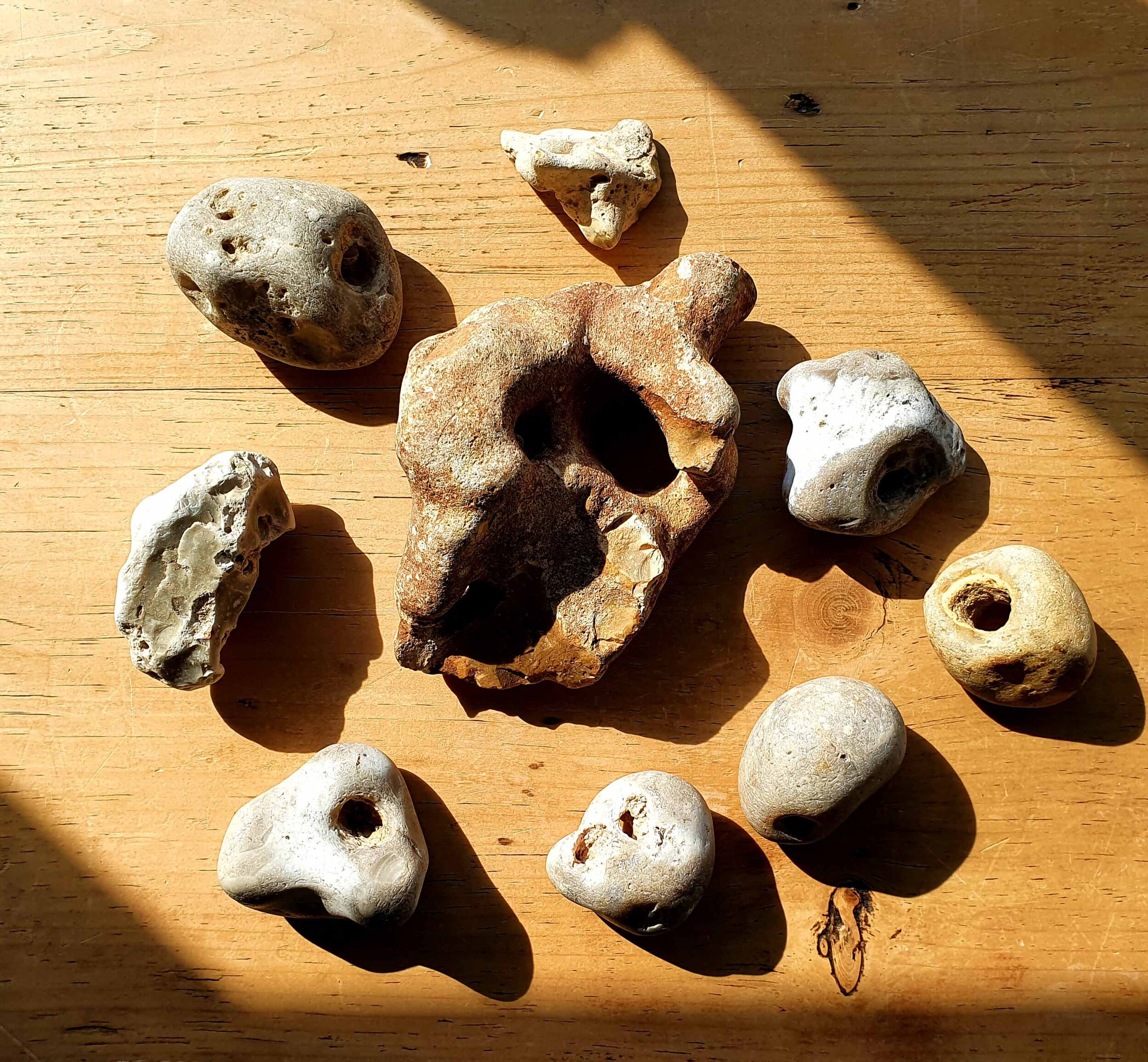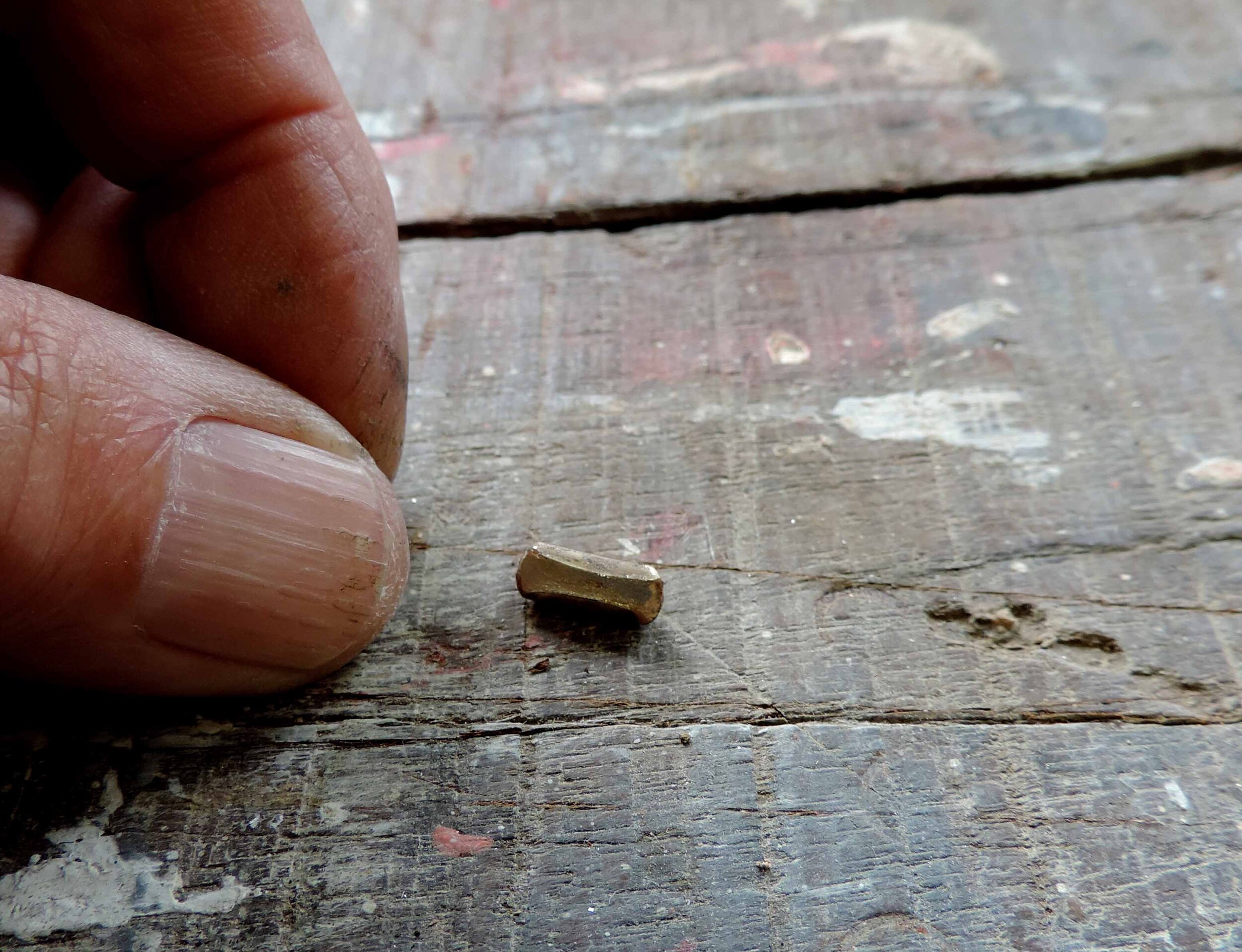My re-creation of hagstones in precious metals.
Hagstones have many names. Adder stones, witch stones, fairy stones, holy stones (sacred) or holey stones (secular), serpents eggs, snakes eggs, hex stones, wish stones, Odin’s stones, Ephialtes stones, milpreve in Cornwall, glain neidr in Wales, gloine nan Druidh in Scotland, none of which apart from the Celtic are often site specific.
Hagstones are any natural stone with a hole worn through the middle by water action, be it sea or river. A friend once found a segment of an airbrick on a local beach rounded off by wave action and the hole was of course part of the brick’s original moulded structure so officially not a hagstone, but who cares, it’s a pretty and tactile object in its own right.
Having lived most of my life close to the beaches of Branscombe and Lyme Regis my children, when young used to collect hagstones. The collection has accompanied us from house to house over the years shedding a few at each move. They are small to medium sized pebbles made of grey chert and occasionally black flint with a hole or holes, worn obliquely or straight through the middle. The folklore surrounding them has always fascinated me. They are believed to ward off the evil eye.
Many of the nearby East Devon longhouses had one nailed to the lintel of the front door or hung by rope on the door itself doubling up as a knocker. Some are found nailed above cattle stalls in case a witch comes in the night and the beasts are ‘hag ridden’. Some fishing boats on Beer and Sidmouth beaches still have a pair screwed just below the bow on each side of the stempost in the manner of Mediterranean fishing boats which have The Eye of Osiris painted in the same place. I knew a dowser in the village of Upottery who used one as a pendulum. He was a man who did it not just as a hobby but who earned a living dowsing. He would be consulted by South West Water prior to drilling a bore or as in the case of Occidental Petroleum, map dowsing for potential oil bearing ground on sites throughout South East Asia. I’ve tried a hagstone for dowsing myself but didn’t find it heavy enough, or should I say dense enough having been used for years to brass bobs with a gold and silver core.
So any natural stone with a hole through the middle can be called a hagstone but my favourites are the chert examples, easily found (well, easily if you have small children) on the beaches or within the plough of the chalk country in the UK.
Over twenty years ago I was asked by a client to copy her favourite hagstone, full size, in silver. She gave me a silver teapot and sugar basin to melt down for the bullion. I had to make an exact wooden copy of the stone then sand cast from that pattern. It turned out to be a beautiful thing – so heavy in the hand once picked up was difficult to put down – so tactile. I also suggested making a scaled-down version to be worn on her charm bracelet. The original was roughly sixty-five millimetres by fifty so the larger version in silver came out as quite a lump. She wanted the smaller stone to be fifteen millimetres at its largest dimension.
The obvious solution was to model her stone in wax and have a casting done from that wax. It didn’t work. No matter how hard I tried I just couldn’t get the swell, bulge and proportion of the original. I decided to do it the hard way, melting and casting a 20-gram bead of silver then forging, filing, grinding and graving it by hand. I had to solder a steel rod to the piece so as to hold it, as being basically spherical it rolled away from the fingers when using a rough file and bounced away when forging. When I’d done one side I’d remove the rod and re-solder it to the other.
After one or two false starts I found the groove. I realised the landscape I was operating within to be more akin to the features of the rock I had climbed when I was younger. At once, under a 10X lens a host of features, zawns, cols, cwms, cirques, flakes, talus were all there in miniature. It then became easier, I knew where I was - I could find my way around the piece adding here, taking away there – feeling my way as I went along. So this is how I became entranced by these magical little stones… well not quite, the magic started a little over fifty years ago.
When I was about twelve or thirteen I used to get the bus up and out of Sheffield with a school friend, Neil - we would spend the day exploring the high limestone country of the Peak District between Castleton and Bakewell. On one occasion while digging around old lead mine workings looking for fossils I found a chert hagstone. Having never seen one before and recognising that it didn’t belong here amid all this carboniferous limestone I took it to school to show my geography teacher. He told me they were prized by the Romans who had also extracted lead from the hills of Derbyshire and his opinion was that it had been brought there from the south coast of Britain nearly 2000 years ago. Ten years later I would move to that area. I lost that stone years ago. I wonder who has it now or has it been temporarily returned to the earth?
My friend Vanessa told me Americans have a special name for them but when I recently asked a friend born there, she just said fairy stones, as when she found her first one on a gravel country road between farmland in central Illinois, was so impressed she supposed fairies must have made it. It is also worthy of note that my friend on another occasion gleaned a Native American axe head and a grinding stone from those same fields on the family farm. Are the two finds connected? Did Native North Americans collect hagstones from other places? Certainly rounded pebbles with holes seem un-connected with the massive scraping of the last glacial retreat from the Central Plain of Illinois 12,000 years ago. Did the indigenous people also venerate hagstones? They did drill holes through stones for personal adornment but these look quite different from hagstones.
This is an ongoing project and I’ll add more soon.





























